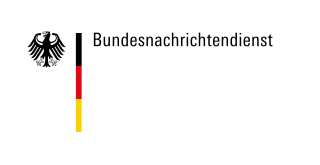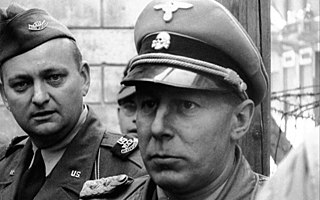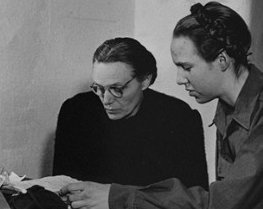
Hans Josef Maria Globke was a German administrative lawyer, who worked in the Prussian and Reich Ministry of the Interior in the Reich, during the Weimar Republic and the time of National Socialism and was later the Under-Secretary of State and Chief of Staff of the German Chancellery in West Germany from 28 October 1953 to 15 October 1963 under Chancellor Konrad Adenauer. He is the most prominent example of the continuity of the administrative elites between Nazi Germany and the early West Germany.

Reinhard Gehlen was a German career intelligence officer who served the Weimar Republic, Nazi Germany, the U.S. intelligence community, and the NATO-affiliated Federal Republic of Germany during the Cold War.

The Federal Intelligence Service is the foreign intelligence agency of Germany, directly subordinate to the Chancellor's Office. The BND headquarters is located in central Berlin. The BND has 300 locations in Germany and foreign countries. In 2016, it employed around 6,500 people; 10% of them are military personnel who are formally employed by the Office for Military Sciences. The BND is the largest agency of the German Intelligence Community.

Walter (Walther) Rauff was a mid-ranking SS commander in Nazi Germany. From January 1938, he was an aide of Reinhard Heydrich firstly in the Security Service, later in the Reich Security Main Office. He worked for the Federal Intelligence Service of West Germany (Bundesnachrichtendienst) between 1958 and 1962, and was subsequently employed by the Mossad, the Israeli secret service. Recruited by Augusto Pinochet, Rauff played a role in the creation of the Chilean internal security apparatus during the military dictatorship. His funeral in Santiago, Chile, was attended by several former Nazis.
A Nazi hunter is an individual who tracks down and gathers information on alleged former Nazis, or SS members, and Nazi collaborators who were involved in the Holocaust, typically for use at trial on charges of war crimes and crimes against humanity. Prominent Nazi hunters include Simon Wiesenthal, Tuviah Friedman, Serge Klarsfeld, Beate Klarsfeld, Ian Sayer, Yaron Svoray, Elliot Welles, and Efraim Zuroff.
Gerhard Wessel was President of the Federal Intelligence Bureau from May 1968 to December 1978. He previously served in the Reichswehr (1932–35) and Army, including the Foreign Armies East of Reinhard Gehlen during World War II. After the war, he was part of the Gehlen Organisation, and then the Bundeswehr (1956–1952).
Heinz Höhne was a German journalist and author, who specialized in Third Reich military and West German Cold War foreign intelligence history.

Gudrun Margarete Elfriede Emma Anna Burwitz was the daughter of Heinrich Himmler and Margarete Himmler. Her father, as Reichsführer-SS, was a leading member of the Nazi Party, and chief architect of the Final Solution. After the Allied victory, she was arrested and made to testify at the Nuremberg trials. Never renouncing Nazi ideology, she consistently fought to defend her father's reputation and became closely involved in Neo-Nazi groups that give support to ex-members of the SS. She married Wulf Dieter Burwitz, an official of the extremist NPD.
While the United States was involved in the prosecution of people involved in the war crimes of World War II, US military and intelligence agencies protected some war criminals in the interest of obtaining technical or intelligence information from them, or to recruit them for intelligence work. The relationships with German war criminals started immediately after the end of the Second World War, but some of the relationships with Japanese war criminals were slower to develop.
Heinz Paul Johann Felfe was a German spy.
Gerald Steinacher is Professor of History and Hymen Rosenberg Professor of Judaic Studies at the University of Nebraska-Lincoln. After serving at the South Tyrolean Regional Archives in Bozen, he was a Joseph A. Schumpeter Research Fellow at Harvard University during 2010-2011 and in 2009 a visiting scholar at the Center for European Studies at Harvard University. He lectured at the Universities of Innsbruck (Austria), Luzern (Switzerland) and Munich (Germany). In 2006 he was a Center for Advanced Holocaust Studies Fellow at the United States Holocaust Memorial Museum in Washington, DC.
The Gehlen Organization or Gehlen Org was an intelligence agency established in June 1946 by U.S. occupation authorities in the United States zone of post-war occupied Germany, and consisted of former members of the 12th Department of the German Army General Staff. It was headed by Reinhard Gehlen who had previously been a Wehrmacht Major General and head of the Nazi German military intelligence in the Eastern Front during World War II.
Operation Scherhorn or Operation Berezino or Operation Beresino was a secret deception operation performed by the NKVD against the Nazi secret services from August 1944 – May 1945. It was proposed by Joseph Stalin, drafted by Mikhail Maklyarsky and executed by Pavel Sudoplatov and his NKVD subordinates, assisted by German antifascists and communists.
Foreign Armies East, operated as a military-intelligence organization of the Oberkommando des Heeres (OKH) - the Supreme High Command of the German Army before and during World War II. It focused on analyzing the Soviet Union and other East European countries before and during the war.

Friedrich Panzinger was a German SS officer during the Nazi era. He served as the head of the Reich Security Main Office (RSHA) Amt IV A, from September 1943 to May 1944 and the commanding officer of three sub-group Einsatzkommando of Einsatzgruppen A in the Baltic States and Belarus. From 15 August 1944 forward, he was chief of RSHA Amt V, the Kriminalpolizei. After the war, Panzinger was arrested in 1946 and imprisoned by the Soviet Union for being a war criminal. Released in 1955, he was a member of the Bundesnachrichtendienst. In 1959, Panzinger committed suicide in his jail cell after being arrested for war crimes.

Wolbert Klaus Smidt was a high-ranking German secret service official, diplomat and publicist. He was First Director at the German Federal Intelligence Service (Bundesnachrichtendienst) and Embassy Counselor in Paris.
Heinz Michael Pannwitz was a German Nazi Gestapo officer and later Schutzstaffel (SS) officer. Pannwitz was most notable for directing the investigation into the assassination of Obergruppenführer Reinhard Heydrich on 27 May 1942 in Prague.
Siegfried Dombrowski was an East German army officer who rose to the rank of "Oberstleutnant" . He combined this with his role as deputy chief-of-staff of Intelligence Administration of the East German military intelligence agency. On 5 August 1958, accompanied by his wife and children, along with a substantial sum of cash, he escaped to West Berlin. For the western intelligence services he subsequently turned out to be a highly valuable source of information about the organisational structures under which their eastern counterparts operated.
The Study and Training Group for Military Reconnaissance was a highly classified clandestine unit of the foreign intelligence agency of Germany, Bundesnachrichtendienst (BND) from 1964 to 1979.

Heinrich Josef Reiser was a German war criminal, SS officer as well as a member of the Gestapo and the SD. In 1940, he was sent to Paris to work in the Sonderkommando Rote Kapelle. In 1943, Reiser was in line to become the commanding officer of the Sonderkommando Rote Kapelle as a replacement for Karl Giering but was instead transferred to the Karlsruhe Gestapo towards the end of World War II where he was involved in the repression of forced foreign labourers. From 1950 on, he was an intelligence officer of the Gehlen Organization and the resulting Federal Intelligence Service. Reiser became a major proponent for the continued existance of the Red Orchestra espionage group in Europe after the war.








